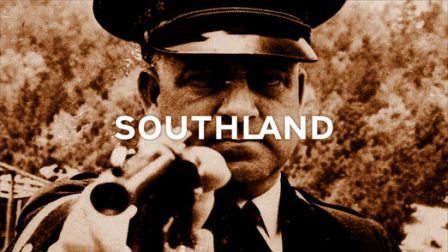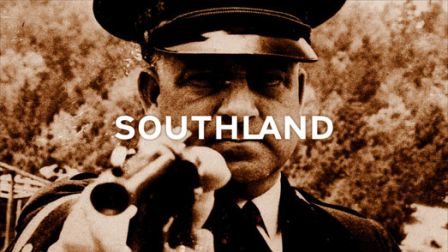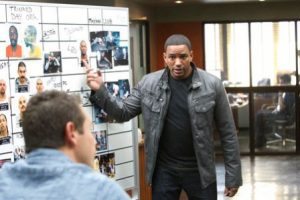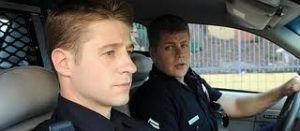Last night was the end of our ride-a-long program with the crew from Southland, and what a ride it was. The season finale proved to be one of the best episodes to date. The action was nonstop. Secrets were uncovered. And the acting was so doggone realistic it almost made me radio for back up a couple of times.
These guys are comfortable playing their parts, which adds to the realism. So many actors try to wear a police uniform, but their feeble attempts come off as clumsy and sometimes even clownish. There’s a huge amount of pride that goes into putting on a police uniform, and that pride exudes from each of the actors on this show. No one had to tell me that these guys have spent some time hanging out with real LAPD officers. It shows. And that extra effort, along with the wonderfully layered individual plots and stories, is what makes this show a cut above the rest.
Last night’s show opened with a statement that was very powerful. It went something like this…”On this night, Officer Ben Sherman would learn that a cop is only as strong as his partner.”
My early days as a police officer were spent working for a county sheriff’s office. The department was small with a very tight budget, which often meant working an entire county alone, or with only one other deputy. Many times we weren’t afforded the luxury of calling for back up to get us out of tight jams, and believe me, I’ve got the scars to prove it. So we learned to be creative. We also learned the strengths and weaknesses of our individual coworkers. For example, we knew not to wade into a mob of knife-wielding drunks when working with one of the smaller statured, less aggressive deputies. If we did, we’d spend a good portion of our much-needed energy protecting our partner, which was like tying one hand behind your back before jumping into the melee.
However, when teamed up with someone like…
Well, the sky was the limit.
So, the voice-over was absolutely correct…A cop is only as strong as his partner.
This episode was crammed full of action and individual stories, so we’re only going to hit the high points, starting with…
Cooper, Sherman, and Chickie find themselves crammed into a single patrol car, and there’s nothing worse than being the low officer on the totem pole, because that’s the officer who gets the back seat. Remember, this is the seat that’s been occupied by puking, urinating, sweaty drunks with greasy, lice-infested hair. And, the rear door locks and windows are normally inoperable, or they’re controlled by the driver. Not to mention that you’re riding in a cage with little or no visibility. Oh, and the leg room is worse than that of coach seating on a commercial airline.
The three officers are riding together as part of a maximum deployment operation, hoping to nab a serial rapists posing as a police officer. The idea of a maximum deployment is to flood the streets with as many officers as possible. We, too, did this when special problems arose. It can be very effective. Costly, but effective.
Lydia is pleasantly surprised to find her old partner, Russell, back on the job, and the reunited duo quickly take on a double murder case. The crime scene is messy (shotgun blasts) and Russell soon learns he’s still physical incapable of helping his partner with the investigation.
Lydia asks someone—a person from the M.E.’s office, I guess—if they know the time of death. The person glances at one of the victims and says, “Lividity puts it between 1 and 2.” This was a bit disappointing to hear, especially from a show that puts so much emphasis on getting it right. Why? Because lividity (the draining of blood to the lowest portions of the body due to gravity) isn’t really used to tell time of death. It’s just not an accurate indicator. Sure, lividity has its own medico-legal purpose, but that’s normally to tell investigators if a body has been moved after death occurs.
The process of lividity begins immediately after death, but we normally begin to see its effects, the reddish/purple staining of tissue, within 1-2 hours after death and becomes fixed between 6-12 hours after death.
Here’s a chart depicting the important changes in a body that take place after death.
Time since death…..Change observed
1-2 hours: ………Early signs of lividity.
2-5 hours: ………Clear signs of lividity throughout body.
5-7 hours: ………Rigor mortis begins in face.
8-12 hours: …….Rigor mortis established throughout the body, extending to arms and legs.
12 hours: ……….Body has cooled to about 250C internally. Lividity is fixed.
20-24 hours: …..Body has cooled to surrounding temperature.
24 hours: ……….Rigor mortis begins to disappear from the body in roughly the same order as it appeared.
36 hours: ……….Rigor mortis has completely disappeared.
48 hours: ……….Body discoloration shows that decomposition has begun.
We see John Cooper and Chickie arguing again. Cooper tries to convince Chickie that she’s unfit for work on the street, and unfortunately for her, she proves him right when the trio (Ben, John, and Chickie) approach a car owned by a man they believe may be the rapist. Chickie gives the guy the command, “Could you shut off your engine and get out of the car, please?”
Remember, the rapist is a dangerous man.
The man (who, by the way, was making out with a woman in the front seat when the officers showed up), asks the question they all ask, “Why?”
Chickie responds, “Why?”
This was not the time to lose control, allow the guy to stall, and give the suspect time to grab a weapon.
Ben, sensing Chickie’s loss of command presence, immediately took control, ordering the guy out of the car. He then went through the textbook commands of, “Walk backwards toward me, hands behind your head, interlock your fingers, etc.”
Cooper then stepped up to order the woman out of the car…”Passenger, step out of the car…”
Great scene. Shows how it’s really done. It was just the wrong guy.
The trio (John, Ben, and Chickie) hear what sounds like an automobile crash. They immediately call it in and report to the scene. The vehicle is overturned with the injured driver trapped beneath. What happened next was very realistic. I’ve seen things similar to this done more than once over the years. Cooper tells other officers to push down on the rear of the car while he and Sherman lift the front. The weight is lifted from the victim, which allows Chickie to pull the guy free. Then, the three officers continue about their business. Unfortunately, part of that business is dealing with Cooper’s injured back—an injury that could take him off the streets for good. But he deals with it in his own way, through his addiction to pain killers.
In the final scene, Chickie is on her way home from work, in plainclothes, and runs across the rapists’ faux police car. He’d stopped a woman and was in the process of sexually assaulting her when Chickie found him. After a brief struggle (actually, she pounded the guy’s head quite nicely) Chickie cuffed the rapist. Her final words of the season, “I’m the cop. I’m a cop.”
Looks like she just regained her confidence.
What a great show! I certainly hope TNT treats us to another season.


















